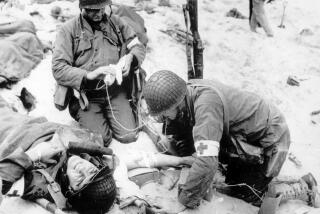Military medicine earns a film salute
- Share via
When Oscar-winning filmmaker Terry Sanders (“Maya Lin: A Strong Clear Vision”) began work on “Fighting for Life,” which opens Friday, the documentary’s focus was on the West Point of military medicine, the Uniformed Services University of the Health Sciences in Bethesda, Md.
Described by its students as “the best medical school no one’s ever heard of,” the university has trained more than 25% of the country’s current active-duty military physicians.
Sanders said he wasn’t interested in doing the film until he visited the university and was struck “by the quality of the school, the maturity of the students and the involvement of the faculty.”
With the growing involvement of the military in the Iraq war, Sanders decided to broaden his scope. “It became an odyssey into the world of military medicine,” he says, “taking me to Iraq and Germany.”
In Iraq, Sanders and his small crew spent 4 1/2 days at the Air Force combat support hospital in Balad. “We filmed continuously with a river of wounded coming it,” says Sanders.
“Our little team were ‘guests’ of the Air Force,” he says. “And I had complete creative control and freedom. What struck me was the skill and the compassion and the dedication of the doctors and nurses, especially in Iraq, working 80-hour weeks.”
But what impressed him even more was the attitude of the wounded. “I never heard anyone complain,” he says. “They had a certain kind of dignity about them and courage and ultimately determination to heal and get well.”
Especially 21-year-old Army Spc. Crystal Davis, who was in a convoy in Ramadi when a bomb blew up her truck and severed her right leg below the knee. She was in danger of bleeding to death when a medic found her.
Sanders follows the plucky Davis from a field hospital to a military hospital in Germany to her rehab stateside at Walter Reed Army Medical Center.
“Crystal just came from the heavens, so to speak,” Sanders says. “She was an incredible woman. She had incredible strength and toughness.”
And she’s still in the Army. “In the film we see her walking for the first time with the help of a cane, but I saw her five months later at a screening of the film in Washington, D.C., and she had no cane, no wheelchair. She was amazingly adept and agile. She was like a ballerina.”
-- Susan King
More to Read
Sign up for Essential California
The most important California stories and recommendations in your inbox every morning.
You may occasionally receive promotional content from the Los Angeles Times.











